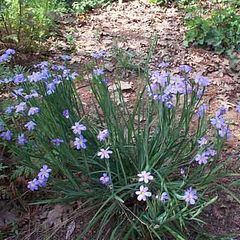Blue-eyed grass: Difference between revisions
m Sisyrinchium moved to Blue-eyed grass: per SSN, WP |
mNo edit summary |
||
| Line 1: | Line 1: | ||
{{SPlantbox | |||
|genus=Sisyrhychium | |||
|species=bellum | |||
|habit=grass | |||
|Min ht metric=cm | |||
|Max ht box=18 | |||
|Max ht metric=in | |||
|lifespan=perennial | |||
|exposure=sun | |||
|water=dry | |||
|features=naturalizes, drought tolerant | |||
|flower_season=early spring | |||
|flowers=blue | |||
|Temp Metric=°F | |||
|jumpin=This is the plant information box - for information on light; water; zones; height; etc. If it is mostly empty you can help grow this page by clicking on the edit tab and filling in the blanks! | |||
|image=Sisrynchium.jpg | |||
|image_width=240 | |||
}} | |||
__NOTOC__{{Plantbox | __NOTOC__{{Plantbox | ||
| name = ''LATINNAME'' <!--- replace LATINNAME with the actual latin name --> | | name = ''LATINNAME'' <!--- replace LATINNAME with the actual latin name --> | ||
Revision as of 07:39, 19 December 2009
| Sisyrhychium bellum subsp. var. | ||||||||||||||||||||||||||||||||||||||||||||||||||||||||
|---|---|---|---|---|---|---|---|---|---|---|---|---|---|---|---|---|---|---|---|---|---|---|---|---|---|---|---|---|---|---|---|---|---|---|---|---|---|---|---|---|---|---|---|---|---|---|---|---|---|---|---|---|---|---|---|---|

|
|
| ||||||||||||||||||||||||||||||||||||||||||||||||||||||
| ||||||||||||||||||||||||||||||||||||||||||||||||||||||||
LATINNAME {{{latin_name}}}
|
'
| ||||||||||||||||||||||||||||||||||||||||
|---|---|---|---|---|---|---|---|---|---|---|---|---|---|---|---|---|---|---|---|---|---|---|---|---|---|---|---|---|---|---|---|---|---|---|---|---|---|---|---|---|---|

|
|
| |||||||||||||||||||||||||||||||||||||||
| |||||||||||||||||||||||||||||||||||||||||
| Standard Cyclopedia of Horticulture |
|---|
|
Sisyrinchium (an old Greek name first applied to some other plant). Iridaceae. Satin Flower. Blue-Eyed Grass. Rush Lily. Hardy or half-hardy perennials, usually with fibrous roots, sometimes used in the hardy border. Stems simple or branched, 2-edged or winged: lvs. grass-like, lanceolate or terete: fls. small, fugacious, in umbellate clusters from a usually 2-lvd. spathe, blue or yellow, perianth nearly flat or bell-shaped, segms. 6, nearly alike: caps. globular, 3-angled.—About 150 species, all American, mostly in moist fields and sandy places and along shores. The species are of easy cult. in any good garden soil. They are very little known as horticultural subjects. CH
|
Cultivation
- Do you have cultivation info on this plant? Edit this section!
Propagation
- Do you have propagation info on this plant? Edit this section!
Pests and diseases
- Do you have pest and disease info on this plant? Edit this section!
Species
Gallery
If you have a photo of this plant, please upload it! Plus, there may be other photos available for you to add.
-
photo 1
-
photo 2
-
photo 3
References
- Standard Cyclopedia of Horticulture, by L. H. Bailey, MacMillan Co., 1963
External links
- w:Blue-eyed grass. Some of the material on this page may be from Wikipedia, under the Creative Commons license.
- Blue-eyed grass QR Code (Size 50, 100, 200, 500)
